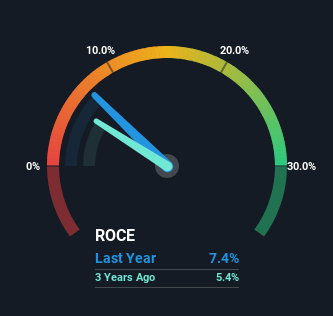To find a multi-bagger stock, what are the underlying trends we should look for in a business? Firstly, we'd want to identify a growing return on capital employed (ROCE) and then alongside that, an ever-increasing base of capital employed. Ultimately, this demonstrates that it's a business that is reinvesting profits at increasing rates of return. With that in mind, we've noticed some promising trends at Changqing Machinery (SHSE:603768) so let's look a bit deeper.
Understanding Return On Capital Employed (ROCE)
For those who don't know, ROCE is a measure of a company's yearly pre-tax profit (its return), relative to the capital employed in the business. The formula for this calculation on Changqing Machinery is:
Return on Capital Employed = Earnings Before Interest and Tax (EBIT) ÷ (Total Assets - Current Liabilities)
0.074 = CN¥189m ÷ (CN¥4.9b - CN¥2.3b) (Based on the trailing twelve months to December 2023).
Thus, Changqing Machinery has an ROCE of 7.4%. Even though it's in line with the industry average of 6.8%, it's still a low return by itself.
Check out our latest analysis for Changqing Machinery

Historical performance is a great place to start when researching a stock so above you can see the gauge for Changqing Machinery's ROCE against it's prior returns. If you'd like to look at how Changqing Machinery has performed in the past in other metrics, you can view this free graph of Changqing Machinery's past earnings, revenue and cash flow.
The Trend Of ROCE
We're glad to see that ROCE is heading in the right direction, even if it is still low at the moment. The data shows that returns on capital have increased substantially over the last five years to 7.4%. The amount of capital employed has increased too, by 37%. The increasing returns on a growing amount of capital is common amongst multi-baggers and that's why we're impressed.
On a side note, we noticed that the improvement in ROCE appears to be partly fueled by an increase in current liabilities. Effectively this means that suppliers or short-term creditors are now funding 48% of the business, which is more than it was five years ago. Given it's pretty high ratio, we'd remind investors that having current liabilities at those levels can bring about some risks in certain businesses.
Our Take On Changqing Machinery's ROCE
To sum it up, Changqing Machinery has proven it can reinvest in the business and generate higher returns on that capital employed, which is terrific. Considering the stock has delivered 3.9% to its stockholders over the last five years, it may be fair to think that investors aren't fully aware of the promising trends yet. So with that in mind, we think the stock deserves further research.
If you'd like to know more about Changqing Machinery, we've spotted 2 warning signs, and 1 of them doesn't sit too well with us.
If you want to search for solid companies with great earnings, check out this free list of companies with good balance sheets and impressive returns on equity.
New: AI Stock Screener & Alerts
Our new AI Stock Screener scans the market every day to uncover opportunities.
• Dividend Powerhouses (3%+ Yield)
• Undervalued Small Caps with Insider Buying
• High growth Tech and AI Companies
Or build your own from over 50 metrics.
Have feedback on this article? Concerned about the content? Get in touch with us directly. Alternatively, email editorial-team (at) simplywallst.com.
This article by Simply Wall St is general in nature. We provide commentary based on historical data and analyst forecasts only using an unbiased methodology and our articles are not intended to be financial advice. It does not constitute a recommendation to buy or sell any stock, and does not take account of your objectives, or your financial situation. We aim to bring you long-term focused analysis driven by fundamental data. Note that our analysis may not factor in the latest price-sensitive company announcements or qualitative material. Simply Wall St has no position in any stocks mentioned.
About SHSE:603768
Changqing Machinery
Produces and sells stamping and welding automobile components.
Low risk and slightly overvalued.
Market Insights
Community Narratives



